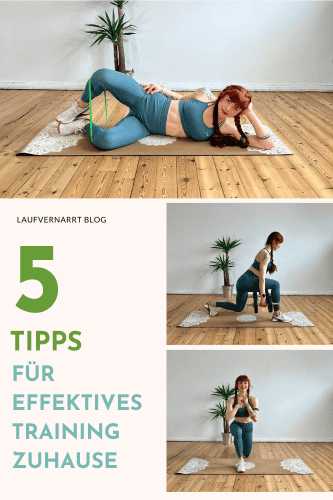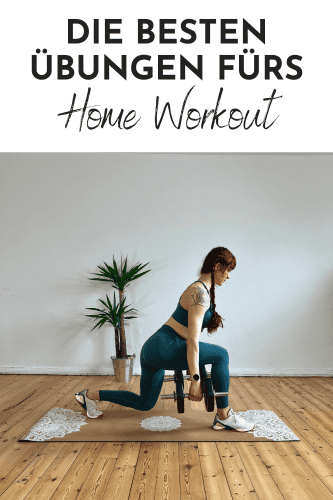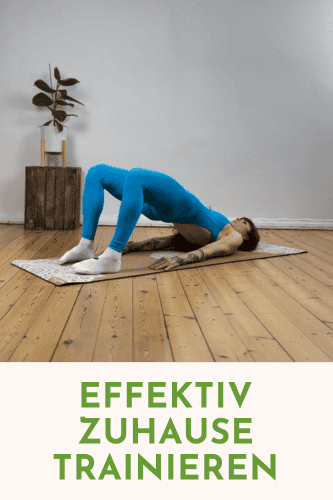How does it actually work? effective training at home? Can you actually train sensibly in your own four walls? Whether building muscle, athletic training for runners or general fitness – home workouts are incredibly popular. In this article you will learn how to get the most out of them and train effectively at home.
Awaiting you:
Effective training at home – is it possible?
Home workouts have an interesting reputation. Many people are convinced that a effective training at home is not possible at all. Still others do random home workouts throughout their lives and are convinced that it will get them to their goals.
How effective training from home is depends less on whether you are in your own four walls and more on whether you use the principles of effective strength training.
Regardless of whether you want to build muscles or, as a runner, want to do strength training to prevent sports injuries, your training at home must be progressive so that it is effective.
Progressive training means that you regularly improve and challenge yourself. This will help you become stronger, more resilient and build muscle. And this is basically possible at home if you approach your home workouts wisely and invest in a few pieces of equipment over the long term.
Can you train at home just as well as in the gym?
Yes, you can train very well at home and achieve very similar results as in the gym. However, this depends a lot on how well equipped your home is and how much space you have. The gym will always give you some additional options for training that you simply don’t have at home. This includes some equipment such as leg presses, leg curls, leg extensions and co. However, with a little skill, you can train just as effectively in your own four walls.
This is what you need for effective training at home
If you think that you can train permanently from home with your own body weight and achieve the same results, I’m afraid I have to disappoint you.
Training with your own body weight is a great option for beginners and is definitely better than no training at all for advanced users. But as your strength and fitness increase, it becomes more difficult to provide progressive training stimuli if you don’t include additional equipment.
You don’t even need a fully equipped “garage gym”. A very minimalistic setup is enough to get you started.

“Starter package” for effective training at home:
If you’re just starting out with home training and want to equip yourself with the basics, I recommend just three investments:
With these devices you can achieve a lot and provide very good training stimuli. For many people, this equipment is long-term sufficient to achieve their goals.
The advantage of training with equipment is not just the increased training stimulus. At the same time, training devices always have a challenging character. This increases motivation compared to pure home workouts with your own body weight.
Equipment for advanced home workouts
Would you like a little more? If you have more budget and space available and would like to expand your equipment for home workouts, the following devices are suitable:
- Dumbbell bench
- Pull-up bar
- Training rack
- Barbell
- more weights
- Endurance equipment such as a rowing machine or treadmill
Effective training at home – 5 tips for your home workout
But how do you get the most out of your training in your own four walls?
You’ve already learned that to train effectively at home, you need to train progressively. Now it’s time for the concrete implementation.


Follow a training plan for effective training at home
One of the most important foundations for effective training – not just at home – is a regular training plan.
If you want to get the most out of your home workouts, you shouldn’t spend your time doing random YouTube or Instagram workouts.
Instead, you follow a targeted training plan that repeats the same sessions over several weeks or months.
This is the only way you can be sure that you improve in the exercises and provide enough stimulus for strength gain, muscle building and greater stability.
How exactly the training plan is structured depends on your training goals. You should train your whole body at least 2-3 times a week. Alternatively, you can also complete 4-5 units per week, alternating between training the upper body and lower body.
Focus on the basic exercises
The basic exercises in strength training form the basis of every training plan – even at home.
These include the basic patterns of movement:
- Pulling from the legs (e.g. Romanian deadlift with dumbbells or straddle lift)
- Pressing from the legs (e.g. Goblet Squat or Suitcase Squat)
- Horizontal pulls (e.g. horizontal or bent-over rows with dumbbells)
- Vertical pulling (e.g. lat pulldown with long resistance band)
- Horizontal pressing (e.g. push-ups or dumbbell bench presses)
- Vertical pressing (e.g. shoulder presses with dumbbells or pike push ups)
- Core/Cary (e.g. Farmers Carry or Pallof Press with long resistance band)
Each of these movement patterns should be included in your training plan at least 1-2 times per week in order to provide an effective training stimulus.


Supplement with unilateral exercises and plyometrics
Especially when Strength training for runners Supplementation with unilateral (one-sided) and plyometric exercises is essential to increase injury prevention.
But even if you train for general health, stability and bone density, you shouldn’t neglect this part of your home training.
These exercises also offer another advantage: they require far less weight to provide a training stimulus, which is why they are a good option for doing at home.
For a “real” squat you need much more weight than for a pistol squat or a split squat. This way you save on equipment for your home.
Incorporate some of the following exercises into your workout:
- Split squats
- Lunges
- Single-leg deadlift
- One-arm lat pulldown
- One-arm shoulder press
- Pistol Squat
- One-arm rowing
- Drop jumps
- Calf hops
- Squat jumps
Improve yourself regularly
Regular increase is one of the most important points for effective training at home.
Only if you challenge your body will it adapt.
And in order to constantly challenge yourself and provide a training stimulus, you need an increase in your training.
When we think of increases we often only think of more weight. But in reality, there are numerous ways you can achieve progression in your training!
- Increase your reps.
- Complete an additional set.
- Work at a slower eccentric pace.
- Increase concentric tempo and incorporate explosiveness.
- Hold the exercise at the hardest point.
- Incorporate 1/4 reps at the hardest point.
- Work with increases in exercise variations. For example, start with an air squat, then move on to a goblet squat and then learn the front squat with dumbbells.
stay tuned
If you want to train effectively at home and make long-term progress, then sticking with it is inevitable.
To achieve and maintain results, you need regular training.
Although maintaining muscle mass and strength requires less effort and time than building it, your body still needs regular stimulation.
“Use it or lose it”
– is the motto here.


Conclusion – effective training at home
To achieve effective training at home, a few additional pieces of equipment are recommended. A starter set of dumbbells, an exercise mat and long resistance bands are enough. If you want more, you can equip yourself further.
It is also essential to apply the basic principles of effective strength training:
- Follow training plan
- Focus on basic exercises
- Supplemented with unilateral and plyometric exercises
- Regular increases
- Keep going
